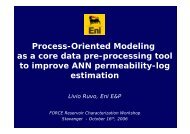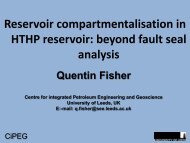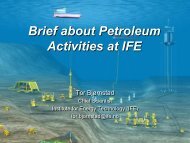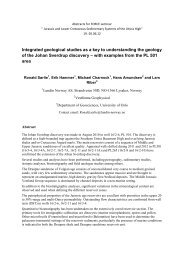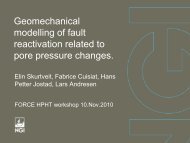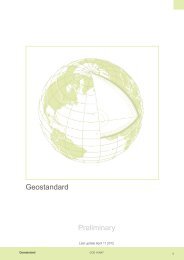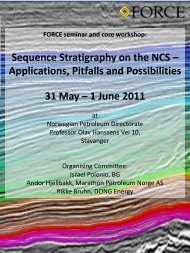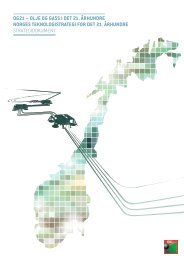analysis of long offset sub-basalt data using model-based ... - Force
analysis of long offset sub-basalt data using model-based ... - Force
analysis of long offset sub-basalt data using model-based ... - Force
You also want an ePaper? Increase the reach of your titles
YUMPU automatically turns print PDFs into web optimized ePapers that Google loves.
ANALYSIS OF LONG OFFSET SUB-BASALTDATA USING MODEL-BASED PROCESSING.JAN OVE HANSEN 1 , BENT TJØSTHEIM 1 , LARS SØNNELAND 1 , SVERRE JÅSUND 2 and BENGT LARSSEN 21 Schlumberger Stavanger Research, P.O.Box 8013, N-4068 Stavanger, Norway2 WesternGeco, Stavanger, NorwaySummaryA novel <strong>model</strong>-<strong>based</strong> procedure for <strong>sub</strong>-<strong>basalt</strong> <strong>analysis</strong> has been proposed [1]. The procedure putcertain constrains on the <strong>of</strong>fset coverage because early arrivals from very <strong>long</strong> <strong>of</strong>fsets areexploited. The results demonstrate that early arrival reflection <strong>data</strong> contains information aboutthe <strong>sub</strong>-<strong>basalt</strong> sediments, and can be used for imaging. Comparisons with conventionalprocessing techniques are made.IntroductionThe continental break up <strong>of</strong> Northern Europe and Greenland during Paleocene was associatedwith transient, massive volcanism. As a consequence many <strong>of</strong> the sedimentary sequences <strong>of</strong>highest hydrocarbon potential are overlaid by lava-deltas.Even though the <strong>basalt</strong>s covers large areas <strong>of</strong> sedimentary sequences <strong>of</strong> the highest hydrocarbonpotential, these areas are still not explored for oil. The main reason being lack <strong>of</strong> technology tomap the sediments underlaying the <strong>basalt</strong>s.The <strong>basalt</strong>s themselves <strong>of</strong>ten act as high velocity - high impedance contrast bodies. Irregularinterfaces <strong>of</strong> the <strong>basalt</strong>s will cause significant scattering <strong>of</strong> the seismic wave field. The highimpedance contrasts cause penetration problems, strong multiples, and mode conversions <strong>of</strong> theseismic waves. All <strong>of</strong> these factors make reliable <strong>analysis</strong> and seismic imaging very challenging.To handle these challenges conventional acquistion and processing methods are inadequate, sonew acquisition and processing methods have to be developed.Results from applying the novel procedure to a <strong>long</strong> <strong>of</strong>fset (~ 12 km) seismic survey will bepresented. With this method a seismic <strong>model</strong> is built as part <strong>of</strong> the <strong>analysis</strong> and <strong>of</strong>fers to identifythe different wave-modes in the observations and to drive the <strong>model</strong>-consistent imaging.AcquisitionData from two surveys acquired <strong>of</strong>fshore the Faroes Iceland are analysed. One survey <strong>using</strong> atwo-boat acquisition geometry with conventional streamer technology (6 km), giving syntheticaperture up to 18 km. A second survey was acquired <strong>using</strong> a single boat with new <strong>long</strong> streamertechnology and a total aperture <strong>of</strong> 11.4 km.Two boat versus single boat configurationThe two-boat acquisition geometry has despite its ability to give us <strong>long</strong> <strong>of</strong>fsets, somefundamental limitations. The <strong>long</strong> recording length needed (12 – 17s) limits the density <strong>of</strong> theshot sampling and thereby the cmp <strong>of</strong>fset sampling. To avoid aliasing problems during multipleImaging <strong>of</strong> <strong>sub</strong>-(ba)salt areas <strong>using</strong> <strong>long</strong>-<strong>of</strong>fset seismic <strong>data</strong> - NPD, Stavanger, Norway 28 th Feb. 2001
emoval several stages <strong>of</strong> interpolation has to be carried out. This is both costly and complicatedbecause <strong>of</strong> streamer feathering. The <strong>long</strong>est <strong>of</strong>fsets contains reflections from <strong>sub</strong>-<strong>basalt</strong> eventstraveling through the high velocity <strong>basalt</strong> layer and comes in earlier than the overburdenreflections. However, the void area in the super shot gather <strong>of</strong> the two-boat geometrycomplicates the <strong>analysis</strong> <strong>of</strong> the early arrivals, since reflections cannot be mapped to normalincident a<strong>long</strong> a continous <strong>of</strong>fset range.Model-<strong>based</strong> processingThe measured reflection response from the <strong>sub</strong>-<strong>basalt</strong> events are complicated by strong multipleenergy, refractions and mode conversions. The velocity <strong>model</strong> built as part <strong>of</strong> the <strong>model</strong>-<strong>based</strong>processing, help to understand the nature <strong>of</strong> the <strong>sub</strong>-<strong>basalt</strong> reflections. Rays traced in the <strong>model</strong>are overlayed the pre-stack seismic and used to identify the observed response. Travel timecurves picked on pre-stack <strong>data</strong> might be depth migrated assuming a given mode (pp, pssp, etc).This procedure gives an improved understanding <strong>of</strong> the sensitivity and the non-uniqueness <strong>of</strong> theinversion problem.Both the moveout and the sorting are predicted by the <strong>model</strong> and is used in the <strong>model</strong>-<strong>based</strong>stacking. The early arrival reflection <strong>data</strong> are mapped <strong>model</strong> consistent to normal incident <strong>using</strong>this approach (Figure 1). Despite the lower frequencies obtained, mainly due to NMO stretchingand attenuation loss, sedimentary reflection events can be observed (Figure 2). Since theseevents are not influenced by the strong multiple energy, valuable information about the <strong>sub</strong><strong>basalt</strong>sedimentary reflections can be extracted. Angle band stacks <strong>of</strong> early arrivals have a goodpotential for mapping faults below the <strong>basalt</strong> (Figure 2). The velocity <strong>model</strong> is also used as inputto pre-stack depth migration (PSDM Figure 2).Conclusions.The <strong>model</strong>-<strong>based</strong> approach proves to be very useful when analysing pre-stack <strong>data</strong> from a<strong>basalt</strong>ic area. Seismic <strong>model</strong>ing helps identifying which wave modes are present in the observedwave field. Further it allows to discriminate between multiples generated in the overburden, andprimary <strong>sub</strong>-<strong>basalt</strong> reflections. In our case the pp-wave energy, the fastest traveling mode, wasalso the most energetic. Model-predicted travel-time curves can be used to map <strong>long</strong> <strong>of</strong>fset earlyarrival reflection <strong>data</strong> with high accuracy to normal incident, giving reliable imaging <strong>of</strong> thesewave modes. The symmetric mode-converted <strong>sub</strong>-<strong>basalt</strong> reflections traveling with lowervelocities are superimposed with shallow reflection events. This makes reliable imaging <strong>of</strong> thesemodes difficult.Comparing the two surveys the single boat <strong>long</strong>-streamer configuration is favorable compared toa two boat geometry, both economically and in terms <strong>of</strong> <strong>data</strong> quality. The improved image <strong>of</strong> thesingle boat configuration is attributed to better multiple attenuation and velocity <strong>analysis</strong>. Also,with the continuous streamer the <strong>long</strong> <strong>of</strong>fset reflection <strong>data</strong> can more easily be understood andmapped to normal incident, since both cmp and shot gathers thus are continuous. The quality <strong>of</strong>the image below top <strong>basalt</strong> is improved when extending the <strong>of</strong>fset range from 0-6 km to 0-12km. Intra-<strong>basalt</strong> reflections, the base <strong>of</strong> the <strong>basalt</strong> and <strong>sub</strong>-<strong>basalt</strong> reflections are improved andmore continuous when including <strong>long</strong>er <strong>of</strong>fsets.AcknowledgmentsThe authors would like to acknowledge the EU Thermie research program OG 144/97 “Sub-Basalt Exploration” for supporting the project.
References[1] Sønneland, Hansen, Tjøstheim, Larssen, Jåsund. “Mapping <strong>sub</strong>-<strong>basalt</strong> reflections <strong>using</strong><strong>model</strong>-<strong>based</strong> <strong>analysis</strong>”. EAGE Annual Mtg., Helsinki, 1999.[2] Kostov, Hoare, Jåsund, Larssen. “Advances in <strong>sub</strong>-<strong>basalt</strong> P-wave imaging with <strong>long</strong> <strong>of</strong>fsetstreamer <strong>data</strong>”. EAGE Annual Mtg, Glasgow, May 2000.Angle corridorMultiple energySub <strong>basalt</strong> early arrivalsFigure 1: Shot gather showing early arrival <strong>sub</strong>-<strong>basalt</strong> reflections with <strong>model</strong>edtraveltime curves overlayed. Offsets from 3000 – 8600 meter are shown.Imaging <strong>of</strong> <strong>sub</strong>-(ba)salt areas <strong>using</strong> <strong>long</strong>-<strong>of</strong>fset seismic <strong>data</strong> - NPD, Stavanger, Norway 28 th Feb. 2001
Pre-stack time mig.Top <strong>basalt</strong>Pre-stack depth mig.Top <strong>basalt</strong>Early arrival imagingTop <strong>basalt</strong>Improved faultdefinitionFigure 2: Comparing <strong>sub</strong>-<strong>basalt</strong> imaging results, pp-wave mode.Top: Conventional time domain processing (0-11.4 km <strong>of</strong>fset)Center: PSDM converted to time (0-11.4 km <strong>of</strong>fset)Bottom: Early arrival <strong>model</strong> consistent imaging (5-11.4 km <strong>of</strong>fset)



